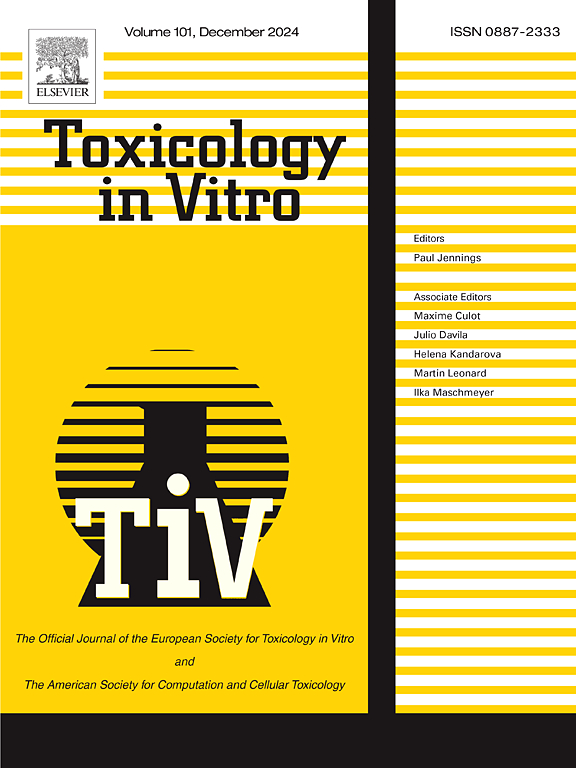β-sitosterol protects against ANIT-induced hepatotoxicity and cholestasis via FXR activation
IF 2.6
3区 医学
Q3 TOXICOLOGY
引用次数: 0
Abstract
Cholestasis, a condition marked by bile acid accumulation in the liver and body systems, leads to liver dysfunction and cirrhosis. Currently, ursodeoxycholic acid (UDCA) and obeticholic acid (OCA) are the only two FDA-approved drugs for Cholestasis. Thus, new therapeutic approaches need to be developed. In this study, we validated the liver-protective properties of β-sitosterol (SIT), a key bioactive element abundant in plants, against hepatic toxicity and cholestasis induced by alpha-naphthylisothiocyanate(ANIT), while elucidating its mechanisms of action both in vivo and in vitro. SIT's FXR activation was confirmed via molecular docking and dual-luciferase assays. In the mechanisms of SIT hepatoprotection, the expression levels of bile salt export pump (Bsep) and multidrug resistance protein2 (Mrp2) which are bile acid efflux transporter, and sulfate transferase 2a1 (Sult2a1) which is a bile acid metabolizing enzyme were all increased by SIT, whereas the expression of uptake transporter sodium taurocholate transporting polypeptide (Ntcp), bile acid synthesis enzyme cholesterol 7α-hydroxylase (Cyp7a1) and oxysterol 12α-hydroxylase (Cyp8b1) was decreased by SIT. In addition, SIT alleviated liver inflammation by suppressing inflammatory factor expression. However, FXR antagonist guggulsterone and FXR siRNA abolished SIT's improvements in liver histology, bile acid transporters, and enzymes. Conclusively, through activating FXR, SIT provides a protective effect against hepatotoxicity and cholestasis. SIT might serve as a new potential therapeutic strategy for the treatment of cholestatic liver diseases.

β-谷甾醇通过FXR激活抗抗抗氧化酶诱导的肝毒性和胆汁淤积。
胆汁淤积症是一种以胆汁酸在肝脏和身体系统中积聚为特征的疾病,会导致肝功能障碍和肝硬化。目前,熊去氧胆酸(UDCA)和奥贝胆酸(OCA)是美国食品及药物管理局批准的仅有的两种治疗胆汁淤积症的药物。因此,需要开发新的治疗方法。在这项研究中,我们验证了β-谷甾醇(SIT)的保肝特性,它是植物中丰富的一种关键生物活性元素,可对抗α-萘基异硫氰酸酯(ANIT)诱导的肝毒性和胆汁淤积,同时阐明了其体内和体外的作用机制。通过分子对接和双荧光素酶试验证实了 SIT 对 FXR 的激活作用。在 SIT 的保肝机制中,胆汁酸流出转运体胆盐输出泵(Bsep)和多药耐药蛋白 2(Mrp2)以及胆汁酸代谢酶硫酸转移酶 2a1 (Sult2a1)的表达水平均因 SIT 而升高、而吸收转运体牛磺胆酸钠转运多肽(Ntcp)、胆汁酸合成酶胆固醇 7α- 羟化酶(Cyp7a1)和氧杂环醇 12α- 羟化酶(Cyp8b1)的表达则因 SIT 而降低。此外,SIT 还能通过抑制炎症因子的表达来缓解肝脏炎症。然而,FXR拮抗剂古格列酮和FXR siRNA会抑制SIT对肝组织学、胆汁酸转运体和酶的改善作用。总之,通过激活 FXR,SIT 对肝毒性和胆汁淤积具有保护作用。SIT可能成为治疗胆汁淤积性肝病的一种新的潜在治疗策略。
本文章由计算机程序翻译,如有差异,请以英文原文为准。
求助全文
约1分钟内获得全文
求助全文
来源期刊

Toxicology in Vitro
医学-毒理学
CiteScore
6.50
自引率
3.10%
发文量
181
审稿时长
65 days
期刊介绍:
Toxicology in Vitro publishes original research papers and reviews on the application and use of in vitro systems for assessing or predicting the toxic effects of chemicals and elucidating their mechanisms of action. These in vitro techniques include utilizing cell or tissue cultures, isolated cells, tissue slices, subcellular fractions, transgenic cell cultures, and cells from transgenic organisms, as well as in silico modelling. The Journal will focus on investigations that involve the development and validation of new in vitro methods, e.g. for prediction of toxic effects based on traditional and in silico modelling; on the use of methods in high-throughput toxicology and pharmacology; elucidation of mechanisms of toxic action; the application of genomics, transcriptomics and proteomics in toxicology, as well as on comparative studies that characterise the relationship between in vitro and in vivo findings. The Journal strongly encourages the submission of manuscripts that focus on the development of in vitro methods, their practical applications and regulatory use (e.g. in the areas of food components cosmetics, pharmaceuticals, pesticides, and industrial chemicals). Toxicology in Vitro discourages papers that record reporting on toxicological effects from materials, such as plant extracts or herbal medicines, that have not been chemically characterized.
 求助内容:
求助内容: 应助结果提醒方式:
应助结果提醒方式:


